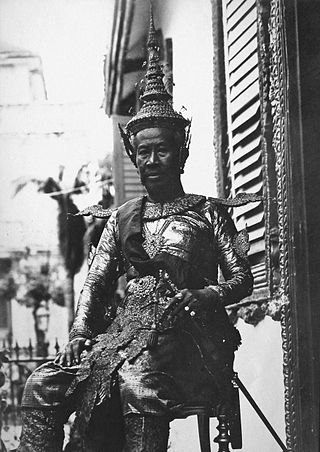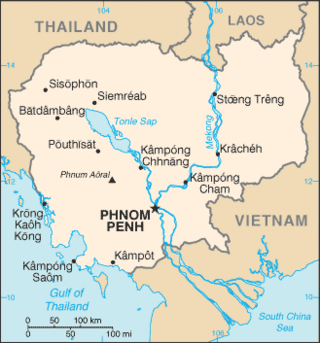
Pol Pot was a Cambodian communist revolutionary, politician and a dictator who ruled Cambodia as Prime Minister of Democratic Kampuchea between 1976 and 1979. Ideologically a communist and a Khmer ethnonationalist, he was a leading member of Cambodia's communist movement, the Khmer Rouge, from 1963 to 1997 and served as General Secretary of the Communist Party of Kampuchea from 1963 to 1981. His administration converted Cambodia into a one-party communist state and perpetrated the Cambodian genocide.

Phnom Penh is the capital and most populous city of Cambodia. It has been the national capital since the French protectorate of Cambodia and has grown to become the nation's primate city and its economic, industrial, and cultural centre. Before Phnom Penh became capital city, Oudong was the capital of the country.

Marshal Lon Nol was a Cambodian politician and general who served as Prime Minister of Cambodia twice, as well as serving repeatedly as defence minister and provincial governor. As a nationalist and conservative, he led the military coup of 1970 against Prince Norodom Sihanouk, abolished the monarchy, and established the short-lived Khmer Republic. Constitutionally a semi-presidential republic, Cambodia was de facto governed under a military dictatorship. He was the commander-in-chief of the Khmer National Armed Forces during the Cambodian Civil War. On April 1, 1975, 16 days before the Khmer Rouge captured Phnom Penh, Lon Nol fled to the United States, first to Hawaii and then to California, where he remained until his death in 1985.

The Kingdom of Cambodia, also known as the First Kingdom of Cambodia, and commonly referred to as the Sangkum period, refers to Norodom Sihanouk's first administration of Cambodia from 1953 to 1970, an especially significant time in the country's history. Sihanouk continues to be one of the most controversial figures in Southeast Asia's turbulent and often tragic postwar history. From 1955 until 1970, Sihanouk's Sangkum was the sole legal party in Cambodia.

The Cambodian Civil War was a civil war in Cambodia fought between the forces of the Communist Party of Kampuchea against the government forces of the Kingdom of Cambodia and, after October 1970, the Khmer Republic, which had succeeded the kingdom.

Sisowath was King of Cambodia from 27 April 1904 to his death in 1927. He was the son of King Ang Duong and half brother of Prince Si Votha and King Norodom. He is the progenitor of the House of Sisowath.
Neil Brian Davis was an Australian combat cameraman who was recognised for his work as a photojournalist during the Vietnam War and other conflicts in the region. He was killed in Bangkok on 9 September 1985, while filming a minor Thai coup attempt.

The Sihanouk Trail was a logistical supply system in Cambodia used by the People's Army of Vietnam (PAVN) and its Viet Cong (VC) guerillas during the Vietnam War (1960–1975). Between 1966 and 1970, this system operated in the same manner and served the same purposes as the much better known Ho Chi Minh trail which ran through the southeastern portion of the Kingdom of Laos. The name is of American derivation, since the North Vietnamese considered the system integral to the supply route mentioned above. U.S. attempts to interdict this system began in 1969.

Kate Webb was a New Zealand-born Australian war correspondent for UPI and Agence France-Presse. She earned a reputation for dogged and fearless reporting throughout the Vietnam War, and at one point she was held prisoner for weeks by North Vietnamese troops. After the war, she continued to report from global hotspots including Iraq during the Gulf War.

The Siamese–Vietnamese War of 1841–1845 was a military conflict between the Đại Nam, ruled by Emperor Thiệu Trị, and the Kingdom of Siam, under the rule of Chakri King Nangklao. The rivalry between Vietnam and Siam over the control of the Cambodian heartlands in the Lower Mekong basin had intensified after Siam had attempted to conquer Cambodia during the previous Siamese–Vietnamese War (1831–1834). Vietnamese Emperor Minh Mạng installed Princess Ang Mey to rule Cambodia as a puppet queen regnant of his choice in 1834 and declared full suzerainty over Cambodia, which he demoted to Vietnam's 32nd province, the Western Commandery. In 1841, Siam seized the opportunity of discontent to aid the Khmer revolt against Vietnamese rule. King Rama III sent an army to enforce Prince Ang Duong's installation as King of Cambodia. After four years of attrition warfare, both parties agreed to compromise and placed Cambodia under joint rule.

Chau Sen Cocsal, also known as Chhum, was a Cambodian civil servant and politician who served as Prime Minister of Cambodia in 1962 and President of the National Assembly twice, in 1962–1963 and 1966–1968. Chhum was awarded the honorary title "Samdech" in 1993 by King Norodom Sihanouk.

General Dien Del was a prominent Cambodian military officer and later, politician. He directed combat operations in Cambodia, first as a general in the Army of the Khmer Republic (1970–1975) and then as a leader of Khmer People's National Liberation Front (KPNLF) guerrilla forces fighting against the Vietnamese occupation (1979–1992). Following Vietnam's withdrawal from Cambodia in 1990, he presided over the demobilization of the KPNLF's armed forces in February 1992. In 1998 he was elected to the National Legislative Assembly as a member of FUNCINPEC. He spent the last fifteen years of his career as advisor to the Cambodian government.

1973 in the Vietnam War began with a peace agreement, the Paris Peace Accords, signed by the United States and South Vietnam on one side of the Vietnam War and communist North Vietnam and the insurgent Viet Cong on the other. Although honored in some respects, the peace agreement was violated by both North and South Vietnam as the struggle for power and control of territory in South Vietnam continued. North Vietnam released all American prisoners of war and the United States completed its military withdrawal from South Vietnam.
Sophat was the first Cambodian romance novel written in 1938 by Rim Kin and was published in 1942. Along with Kolab Pailin and Phka Srapoun, Sophat is widely regarded as the “first” Cambodian novel and is considered one of the three classic novels of Khmer literature, though Tuek Tonle Sap, by Kim Hak had been printed in 1939.

Christ the King Cathedral, also known as the Cathedral of Phnom Penh, was a 19th-century French Gothic revival church that served as the cathedral of the Apostolic Vicariate of Phnom Penh. It was located in the Russei Keo District of the city on Monivong Boulevard.

The fall of Phnom Penh was the capture of Phnom Penh, capital of the Khmer Republic, by the Khmer Rouge on 17 April 1975, effectively ending the Cambodian Civil War. At the beginning of April 1975, Phnom Penh, one of the last remaining strongholds of the Khmer Republic, was surrounded by the Khmer Rouge and totally dependent on aerial resupply through Pochentong Airport.
The Cambodian rebellion of 1820, also known as Neak sel Rebellion, was a Cambodian anti-Vietnamese rebellion led by a monk named Kai.
The Vietnamese invasions of Cambodia refers to the period of Cambodian history, between 1813 and 1845, when the Kingdom of Cambodia was invaded by the Vietnamese Nguyễn dynasty three times, and a brief period from 1834 to 1841 when Cambodia was part of Tây Thành province in Vietnam, undertaken by Vietnamese emperors Gia Long and Minh Mạng. The first invasion that took place in 1811–1813 put Cambodia as Vietnam's client kingdom. The second invasion in 1833–1834 made Cambodia a de facto Vietnamese province. Minh Mạng's harsh rule of the Cambodians finally ended after he died in early 1841, an event which coincided with a Cambodian rebellion, and both which triggered a Siamese intervention in 1842. The unsuccessful third invasion of 1845 resulted in the independence of Cambodia. Siam and Vietnam signed a peace treaty in 1847, allowing Cambodia to reassert its independence in 1848.
Venerable Pang Khat also known as Bhikkhu Viriyapandito was a Cambodian Theravada bikkhu monk who was notorious from 1940 to 1975 and who is most famous for his translations from Sanskrit language to Khmer.
Louis Chauchon was a 20th-century French architect who had a significant architectural influence in French Indochina, designing several major landmarks, especially: the Central Market in Phnom Penh, which is still in use today, and the Cathedral of Phnom Penh, which did not survive the violence of the Indochina Wars.














